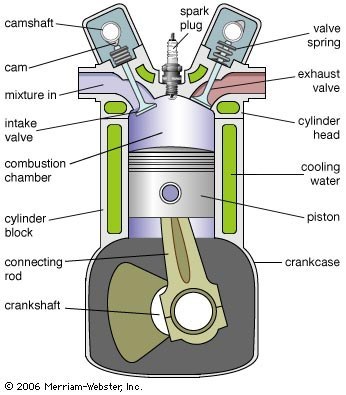The Internal Combustion Engine
We've all heard the sayings, "put the pedal to the metal", "step on it", "punch it" etc., etc. And of course, there's that surge of adrenaline we get every time we floor it. Whether you're in a Ford Pinto passing that proud parent's mini-van or a Ferrari Enzo racing around the track, when you push the gas pedal your engine rumbles and the car takes off. But what really is happening under your hood? We have come a long way from the Flintstone's foot power but do you really know how your car is turning that high dollar gas into forward momentum? Enter the internal combustion engine.
The principle at work here is simple: Air+Fuel+Ignition=Power. Most likely, the type of engine in your car, motorcycle, or lawnmower is utilizing what is known as the 4-Stroke Combustion Cycle. Also known as the Otto Cycle, this system was invented in 1867 by Nikolaus Otto. But what is really important to know is that this system involves four distinct strokes, or steps, in each individual cycle. The four phases involved include the intake, compression, combustion, and exhaust strokes.
The Four Stroke Otto-Cycle
Here is the rundown:
Every one of these of engines is made up of at least one cylinder and atop of these cylinders sits a camshaft. The camshaft rotates, opening and closing the exhaust and intake valves, but more on them in a bit. Each cylinder houses a piston, which will be responsible for the grunt work each time an explosion within the cylinder occurs. The explosion drives the piston down creating downward force. This downward force is transferred into the rotational force needed to turn your wheels by the crankshaft. The crankshaft is connected to the piston by the connecting rod. Now I know what you are thinking…. "Wait…Back up… did he just say there's an explosion in my engine"? Sure did and here's how it happens.

Each piston starts at the top of the cylinder. As the intake stroke initiates the crankshaft turns pulling the piston down. The space created is filled with a mixture of air and fuel, controlled by the intake valve. Once the piston hits the bottom of it's cycle it begins to move back up compressing the aforementioned mixture and the engine moves into the compression stroke. This compression increases the effectiveness of the explosion involved in the next phase, the combustion stroke. As the mixture compresses a spark plug creates a spark, which ignites the mixture. This explosion drives the piston back down, turning the crankshaft. Finally, as the crankshaft pushes up the piston back again any remaining mixture and exhaust from the explosion is pushed out of the exhaust valve. At this point the system has reset and the cycle is ready to start all over again.
Time to revisit our model
And there you have it. All it takes are these four strokes happening over and over hundreds of times a minute and you too can be the next Mario Andretti… or just get passed that mini-van.

